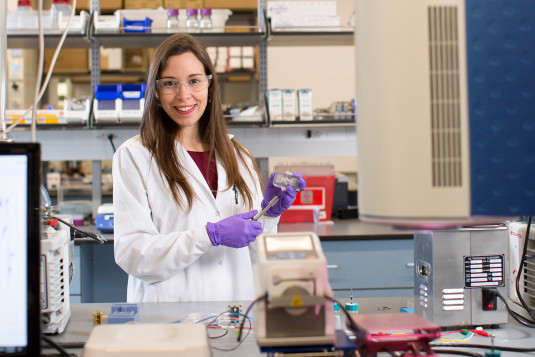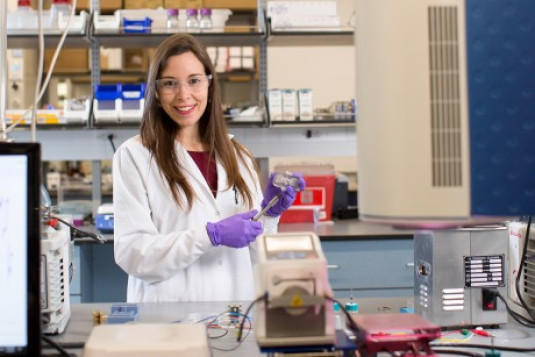
Perseverance and prototypes
When his heat-pump prototype shot a stream of water across the room, Lonnie Johnson realized the technology could create a super-powered water gun. Getting the toy to market, however, would take nearly a decade.
Debuting in 1990, the Super Soaker® was an instant commercial success that led to the water gun's induction into the National Toy Hall of Fame and its inventor — with more than 200 patents — into the National Inventors Hall of Fame.
15 min read
Each month, our Journeys of Innovation series tells the stories of inventors or entrepreneurs whose groundbreaking innovation have made a positive difference in the world. Hear it in their own words or read the transcript below. To read about other National Inventor Hall of Fame (NIHF) inductees, visit Greatest in American Innovation.
Do you know an innovator or entrepreneur with an interesting story?
Linda Hosler: Taking a great idea from concept to market can require years of hard work and unwavering persistence. This is Linda Hosler from the United States Patent and Trademark Office. I recently interviewed Lonnie Johnson, an inventor and engineer, originally from Mobile, Alabama. His journey as an inventor began in high school, when he designed and built his own robot, entered it in a regional science fair, and won first place. Since then he has received more than 200 patents for inventions that include new types of engines, batteries, and spacecraft. In fact, it was his work at NASA that inspired his most famous commercial success in the Super Soaker®—a line of toy water guns. Here is a bit of our conversation.
Linda Hosler: So where did it all start? I like to think of inventors as having an origin story, like a superhero. Is there a moment that defines you when you turned into an inventor?
Lonnie Johnson: A moment that defined me, when I turned into an inventor? I have been inventing and tinkering with things and have always, as far back as I can remember, I've been curious about how things worked and I used to take my toys apart.
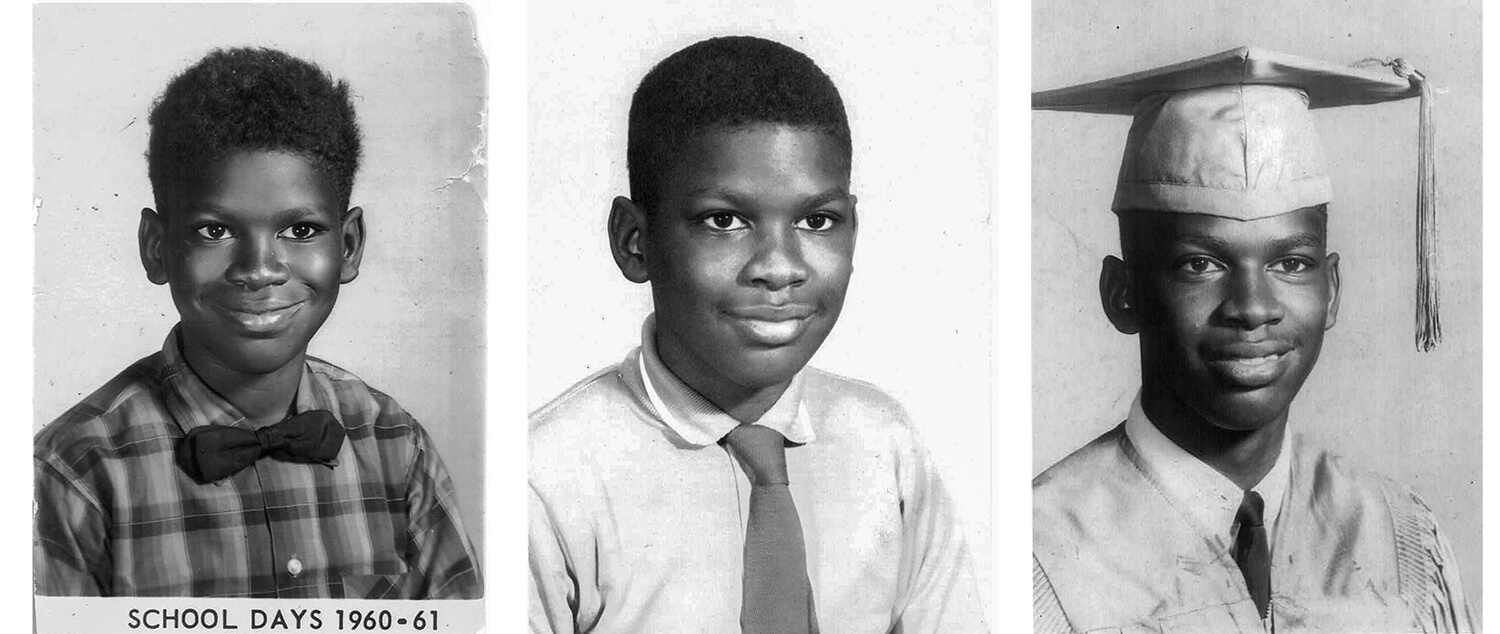
Lonnie Johnson school photos
Lonnie Johnson: I’d take my siblings' toys apart because I wanted to see inside. I can't remember when I was not curious that way. I think you might find, when I—the time I got my first patent, maybe that would officially classify me as an inventor. In reality, we're all inventors. We all have creative minds and I think some of us are focused on tapping into that more so than others.
“In reality, we're all inventors.”
Linda Hosler: One of the most accessible inventions that you created was the Super Soaker®. [LJ: Yes.] Was that a problem you were trying to solve or is it just something that sort of came about?
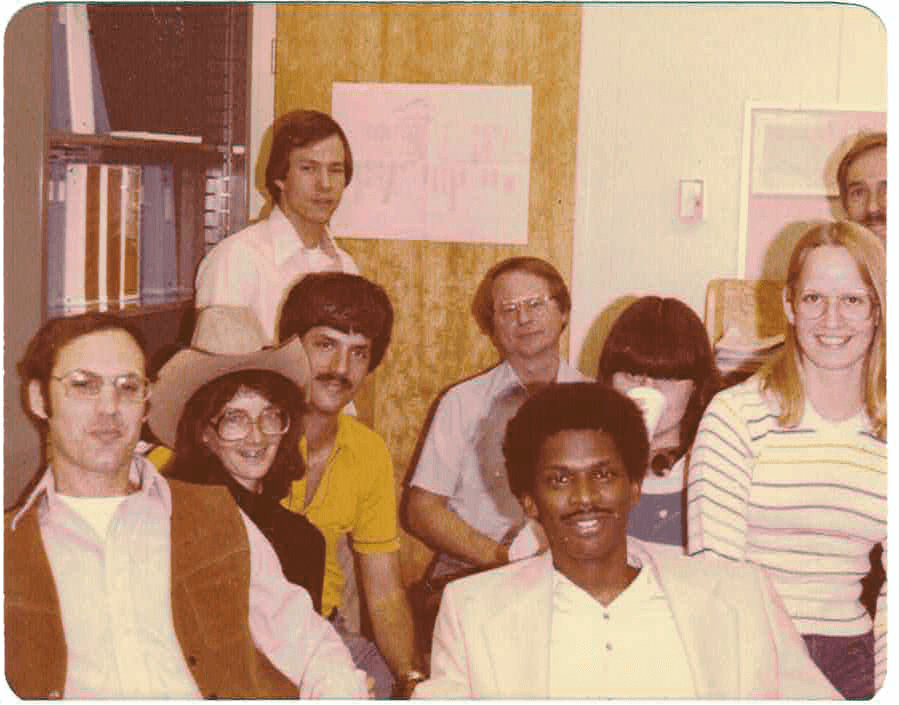
Lonnie Johnson (bottom right) with colleagues at NASA’s Jet Propulsion Laboratory
Lonnie Johnson: Actually, it was a problem. I was working on a new type of heat pump that would use water as a working fluid instead of freon and I was experimenting. I was working for NASA at the time, at the Jet Propulsion Laboratory, and I would go home and work on my own projects, and I machined these nozzles and, and I'd hook them up to the sink in my bathroom, and I was looking at the stream of water coming out of a nozzle, and I turned and shot the stream across the bathroom, and I thought jeez it would be neat to have a really powerful toy water gun. And I thought to myself about inventions that I’d come up with up until that point. In fact, I had gotten my first patent a few years before that point and having trouble getting investors and figuring out how to commercialize some of my other ideas. I felt that a toy would be something that could, anyone could look at it and appreciate, and if I can get that going, then maybe I can get enough income to really become a full-time inventor. So that worked out pretty good.
Linda Hosler: Was there ever a time that you struggled or you felt like you wanted to quit?
Lonnie Johnson: Well, Super Soaker® is a good story along those lines of, you know, being frustrated. And I can remember I was still working a day job, and then I'd go home at night and I'd work on my own projects, and my sleeping hours actually were very short, and I remember one time stopping and thinking to myself jeez, I can conceive of things. I can actually go into my shop, make them, make them work, have demonstrating models and prototypes. Why is this so hard? Why is it taking so long to get some—to achieve some success? Super Soaker®, I got the idea in [1982] and it wasn't until [1989] that I actually got a deal going. It wasn't until [1990] that the toy came out on the market. So it took about eight years to get it on the market.
“There were a lot of false starts, and a lot of reasons to give up.”
LONNIE JOHNSON: There were a lot of false starts along the way and a lot of reasons to give up. One of the companies I was working with actually went out of business trying to do it. Another company where I was going to try and set up manufacturing myself and found out that it was gonna cost a lot more money than a captain in the Air Force was making at the time, so there was just one discouraging event after another, but I think the key to success, and the most important thing above anything else is perseverance. I think sticking to it and not giving up is what makes the difference.
“I think sticking with it and not giving up is what makes the difference.”
Linda Hosler: That's fantastic. So having a mentor and being a part of team is often—I've often heard that that's part of the invention process as well.
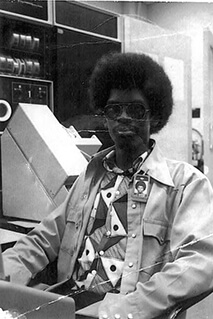
Johnson as a college student at Tuskegee University
Lonnie Johnson: In terms of actual mentors, you know my dad was my first mentor. He wasn't an inventor or anything, but he used to work on the car, and I was always curious about how things worked. When he was working on something around the house, I was Johnny-on-the-spot. I was watching his every move. I think that was—that made a difference, but it wasn't long. He was not, didn't have formal training, so it wasn't long before he couldn't help anymore.
And you find inspiration along the way, you know, wherever you can draw upon it. One of the things that happened, for example, when I was in college, I went to Tuskegee University and that's where the Commodores started when I was a student there. They started on a freshman talent show the year before I got on campus. And one year, one of the stagehands came to me, and said, you know the group is playing in the dark in a lot of nightclubs, and could you come up with some lighting systems? And I say, Oh sure, I can design some. So I designed some lights for the Commodores. And I was really excited about that. So you know, having a problem or a challenge I think is a source of inspiration for me. But I remember later on after I entered the Air Force, and the Commodores and Lionel Richie became very, very famous, and I thought to myself, if they can do it, I can do it too. But why is it taking me so much longer?
At one point they had actually offered me—this was back when I was in college—they offered to have me go on the road with them, and handle their equipment. As I said, no, I don't think I want to be a roadie. I'll stay here and finish my—and get my engineering degree. [LH: Wow, what a cool story.]
Linda Hosler: Was there something that first piqued your interest or made you excited about science?
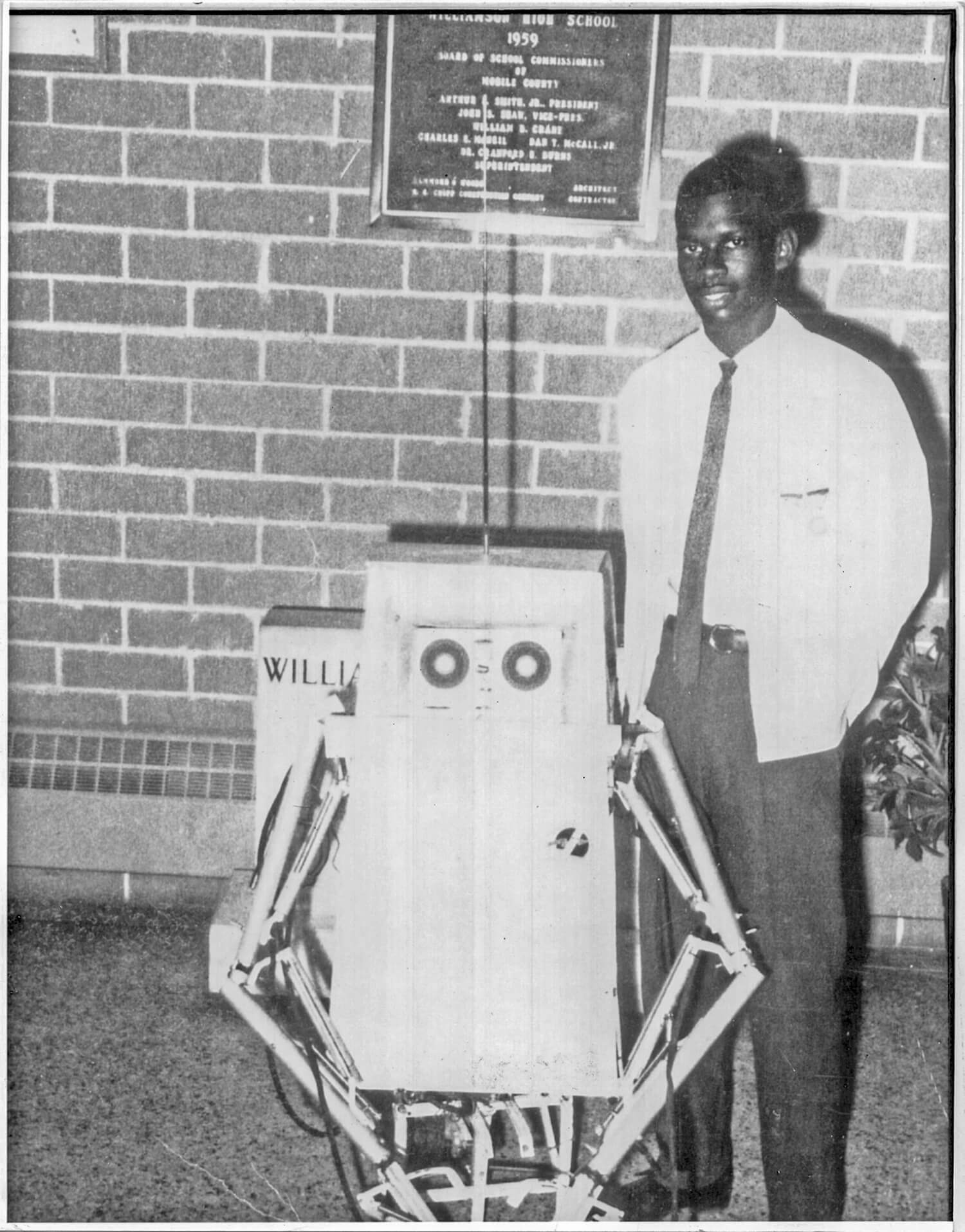
Johnson with the robot he built in high school
LONNIE JOHNSON: I remember when I was 12 years old, it was back in [1962], when President Kennedy made his moon speech: we're going to put a man on the moon before the decade is out. I really was excited and I watched the space program from day one, and all of the different launches as we expanded our capability to really launch vehicles, and even design larger and larger vehicles and improve reliability to all them baby steps along the way of actually building that capability was really, really impressive over a very, very short period of time.
I watched—we used to watch sci-fi, science fiction TV shows, and I used to watch these shows. Robby the Robot was one, and then Lost in Space robot, and I was excited about those. And so at one point I decided I wanted to have my own robot. So I actually built a robot. I built robots, little small things with erector sets and things like that that I had gotten for Christmas, but they were different, so I wanted to have a real robot.
And so I started working on him. It took me about a year, but by the time I got into the twelfth grade, I actually had built my own robot, and he was Linex the Robot, and he won first place at the University of Alabama at a regional science fair in 1968. And that was during the heart of the civil rights movement and it was a major personal victory for me. In fact my senior year in high school was, that was pre-desegregation, and so it wasn’t until after I graduated that my high school was desegregated. So, there was a lot to overcome.
LINDA HOSLER: Shifting gears a little bit could you describe the role that intellectual property has played in the course of your career?
LONNIE JOHNSON: It's been pivotal. Certainly the Super Soaker® patent, the original patent, if it we're not for that patent, I would not have been able to license it with—under the circumstances that we did, and even when the infringers started, we were able to get injunctions put in place based on the patent. We actually stopped shipments coming into the country at the docks in Los Angeles. And I think when we took the first infringer on, the other companies decided to step back and leave it alone. That allowed us to focus on developing the product and proving it, and it became a major success. And I think it's extremely important that if you take the risk, do all the development work, and stick your neck out, and prove that something is possible, and then have everybody jump on, pile on and eat the benefits away from you, that is unfair.
“When we took the first infringer on, the other companies decided to step back and leave it alone.”
Linda Hosler: Could you talk a little bit about taking the Super Soaker® from prototype to patent? How long did it take you? What was that like?
Lonnie Johnson: Well, let’s see, I got the idea in [1982]. Okay, and at the time I was at the Jet Propulsion Laboratory in Pasadena—I decided to go back on active duty in the military—so I got the idea, but I didn't start working on the gun until I actually moved. And when I got my family resettled a few months later—when I had gotten a shop set up in my basement and everything—then I started working on the prototype. Initially I wanted to manufacture the gun myself and set up a company and all this, and I went and talked with injection molding company. And then the owner of the company came back and said, okay it's gonna cost $200,000 and set up the first, set up the production line and get the first thousand guns out. And I thought to myself, I don't have $200,000.
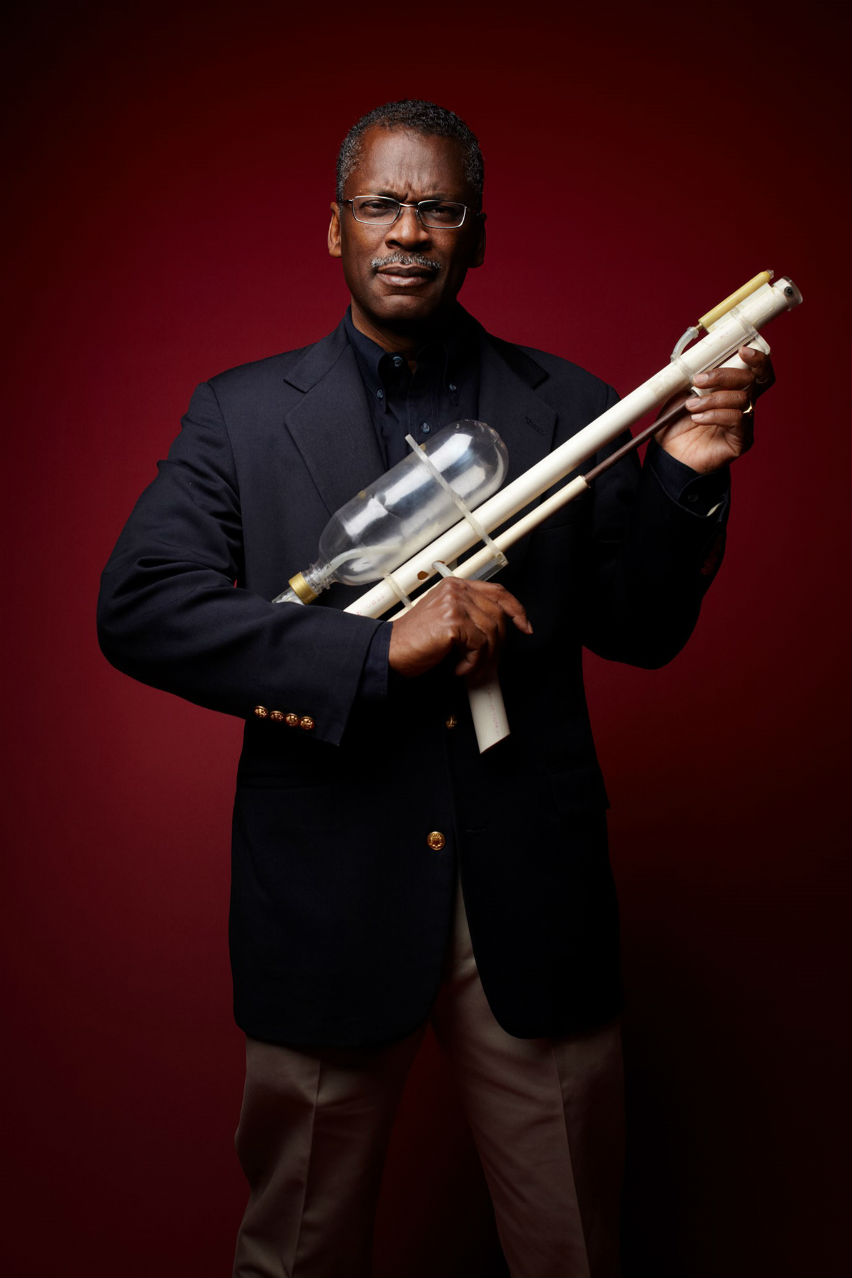

Johnson with an early prototype of his water gun. Photos courtesy of Mike McGregor.
And I realized that I really didn't know very much about business—all my professional work had been you know with the government. And then I started, um, pursuing licensing opportunities. But now it's a situation where I'm going to talk to existing companies, toy manufacturers, about my idea, my baby, and they could just take it and run with it. And then I'd be fighting and trying to get them to acknowledge a contract, or put some kind of contract or instrument in place. But then I decided, well, you know, first off, if nobody knows about it, I can't make any money.
So it really was a conscious decision of being willing to take the risk so that I could learn some things that I didn't know about business in particular, and I thought, you know, that I could follow the process, be involved in the whole process of commercializing a product, and then with that knowledge, I could—I'll be ready for the next project, win or lose.
By [1989], I'm ready to make another stab at it, and I went to New York with the idea of meeting some people at Toy Fair. This is a major trade show for toys. And I literally walked the halls looking for someone to talk to about my invention.
“I literally walked the halls looking for someone to talk to about my invention.”
And it wasn’t like an open trade show, because at Toy Fair you had toy rooms, and you had to know someone in order to get in there because everybody was very secretive about their new product line. So, I ended up talking to the vice president of Larami. And he basically told me in essence, this sounds like an interesting idea, but I can't look at inventions now. We're at a major trade show here. Our headquarters is in Philadelphia. If you're ever in the area and drop in to see us, we'd love to look at your product. So as I was getting up to leave he said to me, “But don't make a special trip.”
And I said, Oh, you burst my bubble right even before I get out the room. And as soon as I got home, I started working on the next version of the gun, because I had not gotten the previous gun back from the other manufactures I had been talking go. They’d take it apart. And it took me a couple of weeks to get a new gun made. And this is the first time I put the bottle on the top, which gave it the ability to hold a whole lot of water, but through other mechanisms: pumping it up, pressurizing, and things like that—that was all fundamental. So after I finished it and I called him up and asked to speak with the president, and I told them that—the vice president, Al Davis—and I said, “Look, I'm going to be in your area next week. Are you available for a meeting?” So I did make a special trip.
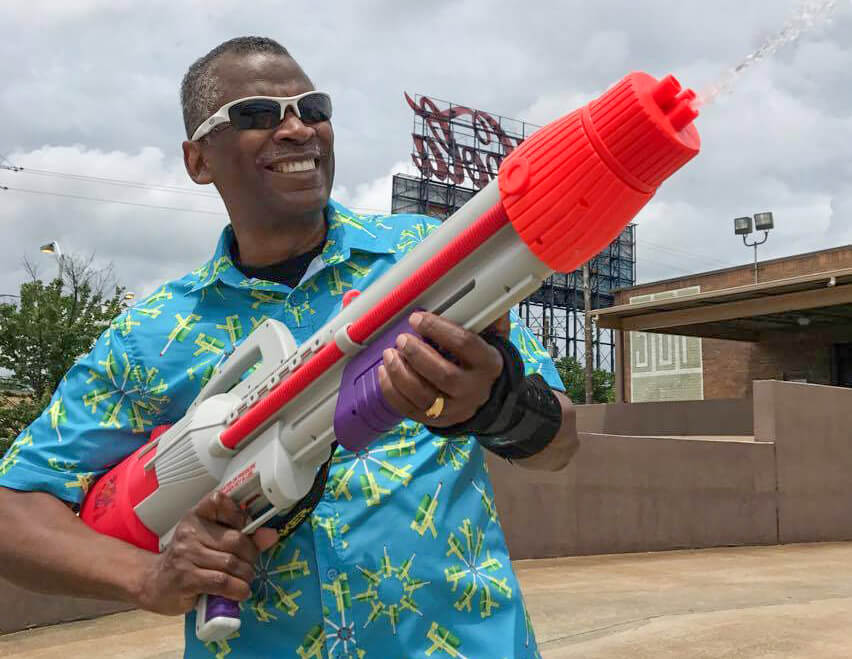
Johnson plays around with a Super Soaker® while wearing a shirt patterned with images of his famous creation
And I went in and they were, all of the—the president of the company there Myung Song, Al Davis, the other staff was there, and he asked me, well, what do you have? I opened up my suitcase. I took it out and pumped it up and fired it across the room. And the president of the company said, wow! It was like, they had never seen a gun perform like that. And then the brainstorming started and I could just sit back and let it happen because I realized that I captured their imagination we were on our path to success. So that was the genesis of the Super Soaker®.
“I realized that I captured their imagination.”
LINDA HOSLER: That's fantastic. Lots of ups and downs.
LONNIE JOHNSON: Oh yeah. Lots of challenges, setbacks, disappointments, all of those things that I know just about every inventor runs into.
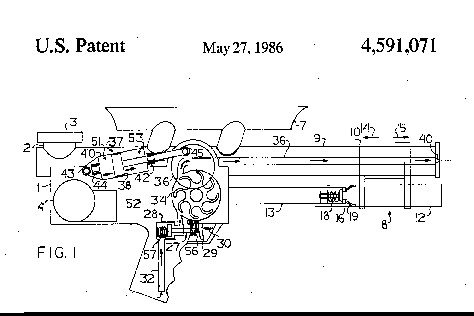

Johnson’s first water gun patent was issued in 1986. Another patent in 1991 would ultimately be commercialized by toy manufacturer Larami as the Super Soaker®. A 1992 patent described further improvements to the design using air pressure instead of water pressure.
LINDA HOSLER: Absolutely. I’m going to shift gears again and ask you a little bit about what kind of advice you might have for other inventors. Again, speaking to a wide audience.
LONNIE JOHNSON: I only have one word of advice: persevere. Nothing else is gonna to make a difference. And it's actually difficult for other people to see your dream. It helps to have a model or a prototype or something like that that you can actually demonstrate. Fortunately the people at Larami were in the toy water gun business already, and when they saw my gun compared to what they had, and they knew what to say luck and perseverance and opportunity. But I think perseverance is a path by which you can make your own luck.
“Perseverance is a path by which you can make your own luck.”
LINDA HOSLER: What do you think it takes to be a good inventor?
LONNIE JOHNSON: I think it takes knowledge more than anything. I think, again, the Super Soaker® is a good example. I realized what I didn't know, and I set out to compensate for that and obtain the information I needed in order to succeed. So, you need to embrace the unknown.
LINDA HOSLER: That’s great. And looking back at the impact of all your inventions and your career, what's the thing you're most proud of?
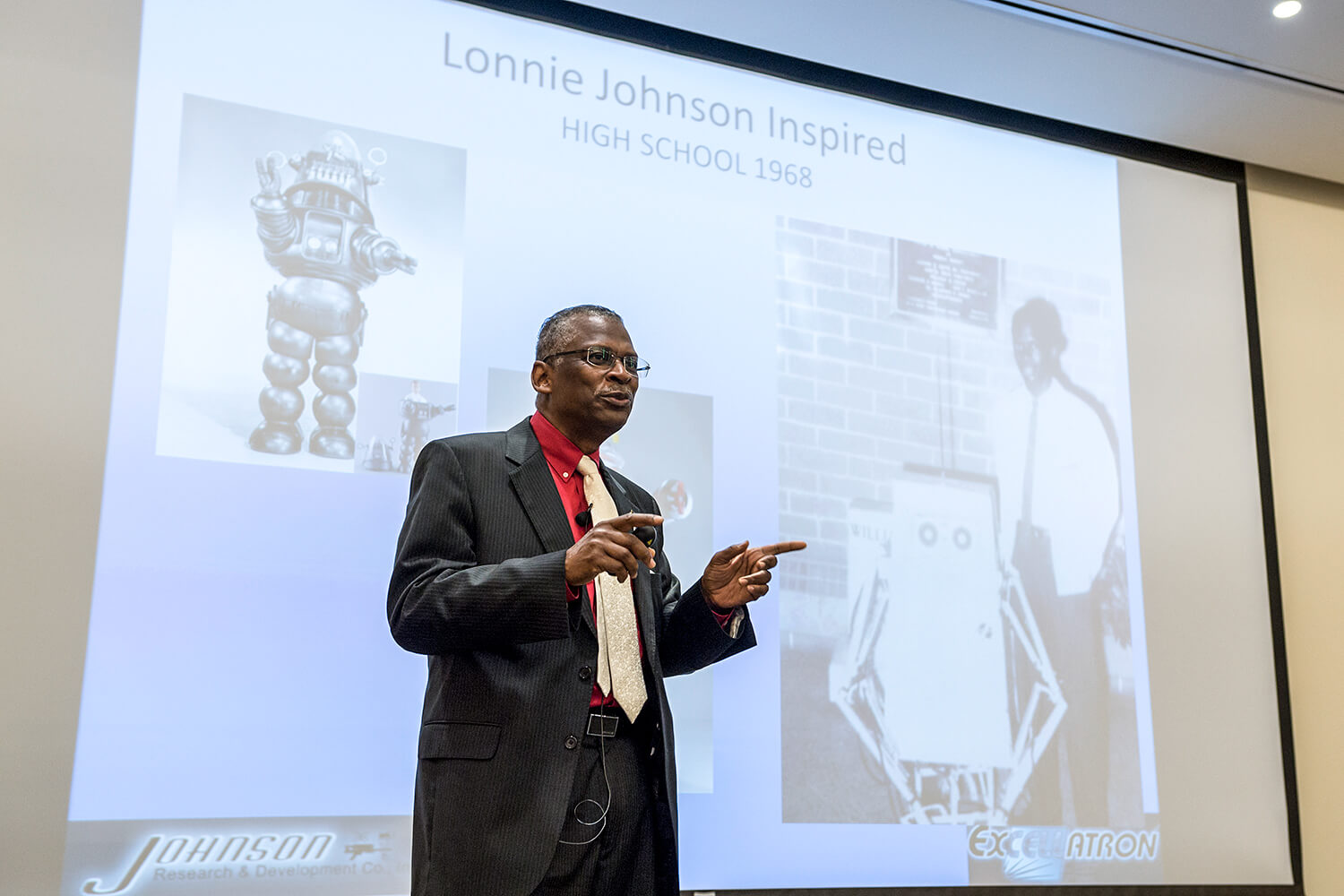
Johnson today, discussing his inspirations and his early years
LONNIE JOHNSON: Wow, well, you know, I don't—that's like asking, well, what's your favorite child; they all have a special place. To answer your question, the robot that I built in high school is a—was a highlight. Getting an invention on an interplanetary spacecraft that my peers at the time—handpicked engineers at the Jet Propulsion Laboratory—was saying would not work, but making it work, and successfully solving a major problem. That was a highlight.
Of course the Super Soaker®. Most people don't know that I'm also responsible to large extent for the success of the Nerf dart gun line. In fact the N-Strike line of products we're based—started based on my patents. And the things I'm working on now, the JTEC, which is a new type of engine that converts heat directly to electricity, more efficient than other engines. And what's really unique about it is that it's all solid state with no moving mechanical parts. And I'm developing an advanced battery technology that could be as much as an order of magnitude higher in energy storage capability than existing batteries.
So these are highlights that I'm excited about it this point.
LINDA HOSLER: This is really fantastic. It's so fun to hear the stories firsthand. So I really appreciate it.
LONNIE JOHNSON: You have a fun job, obviously…
LINDA HOSLER: A big thank you to Lonnie Johnson for taking the time to sit down with us and share his experiences. And thank you for listening.


